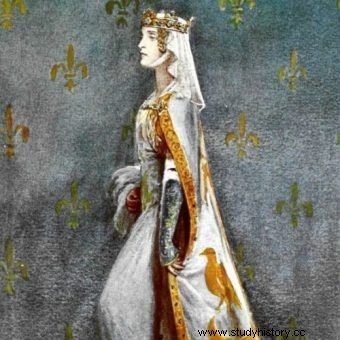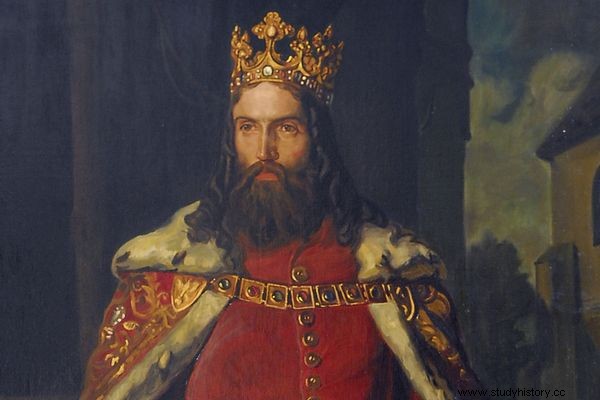There was no blue blood in her veins. She had no honorable origin or royal fortune. So what did Krystyna Rokiczana stand out for? She was an alluring seductress. And a hostile intelligence agent.
You can't put it delicately. In 1356, the King of Poland, Casimir the Great, became a bigamist. And he was only to blame - because not for the first time in his life he showed astonishing naivety in matters of love and marriage.

This is how the Czech court fashion of the 14th century at the beginning of the 20th century was imagined. Portrait of the Luxembourg princess Anna, married to the ruler of England, Richard II. Illustrative illustration:no portraits of Krystyna Rokiczany have survived.
The Polish ruler must have remembered perfectly well how he was fooled a dozen years ago. Then, after the death of his first wife, Aldona Anna, he agreed that the powerful neighbors, who ruled the Czech Republic, Luxembourg, took on the role of matchmakers and offered him a new partner. As a result, he allowed himself to get involved in a private marriage that was completely unsuccessful, politically useless, and dynastically devastating (read more about how this marriage happened in my other article).
Kazimierz's second wife, Adelaide Heska, married in 1341, was as poor as a church mouse, and also turned out to be sterile. The king, who had no male heir, after fifteen years was absolutely sure that he had to get rid of his wife and remarry.
He tried to force Adelaide to break up; He even locked her in one of his locks and imprisoned her there for several months. The Queen, however, remained adamant. It was then that Kazimierz had a really brilliant idea. He decided to ask for help ... the same Luxembourgers who gave him all these marital pleasures.
The perfect ally
Having learned nothing from his disgusting trip to Prague, Kazimierz made another trip to the Czech capital and once again took the advice of a man whom he referred to in diplomatic treaties as his "venerable brother":Emperor Charles IV.
It was at a time when Adelaide's fate had yet to be sealed. The queen was in the fortress in Żarnowiec, but she still wore the crown and remained the official wife of the ruler. The king probably hoped that his Czech partner would get him out of trouble and use his contacts to convince the Pope to break his wedding with Adelaide.

Adelajda Heska on a sketch by Jan Matejko.
Charles could have done it easily, but for what reason? There was a different game in his interest. He wanted Kazimierz to get bogged down in his family excesses, fell to the Holy See and eventually lost the chance to extend the family. After all, the fall of the Piast dynasty must have resulted in years of chaos on the Vistula River, and thus - a further strengthening of the already sizeable Luxembourg empire.
As if that were not enough, Karol also hoped that in a favorable coincidence, he or his descendants would inherit all of Poland. After all, the ruler of Hungary, Ludwik, who was to be Kazimierz's successor, had no sons himself. And the strongest claims to all estates of this line of Anjou were held by the Luxembourgs ...
Second best suggestion
It is impossible to understand why Kazimierz did not take into account all these dependencies. He drove south with complete carelessness and confidence that he would be treated as befitting a friend. Charles did show him all kindness. He did not promise to look into Adelaide's case, but… again, like years ago, he made the second best proposal. Her name was Krystyna.
The emperor did his homework. He knew which ladies made the Polish king's heart beat faster; what kind of beauty he likes, what words excite him, what clothes he cannot resist. He found a woman whom he could say with certainty that Kazimierz would not be able to resist. And who, by the way, was his trusted, faithful helper.

Charles IV of Luxembourg
It was called Rokiczana, it came from the Prague bourgeoisie. She was a swift, mature woman who knew what she wanted. Her father was the mayor of Prague, she herself was brought up in all luxuries and received a proper education. She already had one husband whom she had buried a few years earlier. It certainly did not lack wealth - the patriciate of large trading cities lived at an even higher rate than the magnates. Krystyna was distinguished from all aristocrats and nobles only by the lack of her own coat of arms. And this particular drawback turned out to be extremely important.
"I don't want to live with a king who has a wife"
The lady was led to the Prague court, where she immediately turned Kazimierz's mind. If the Polish king were asked about the beginnings of their relationship, he would probably reply that he was the one who managed to charm and seduce the beautiful townswoman. In reality, however, it was Krystyna who seduced Kazimierz and wrapped him around her finger.
She must have become his mistress in Prague, or at least she made the monarch know that she was ready to become her. At the same time, however, she emphasized that the role of "the latter" was not enough for her and that she did not intend to be equal to the herds of harlots, which the playful king kept in his various castles and private lupanars. She considered herself a classy woman and expected to be treated according to her status.

Casimir the Great in the painting by Leopold Löffler.
Kazimierz seemed completely stupid when he saw it. Regardless of the fact that he still has a wife, he agreed to marry Krystyna. He must have forgotten that such a marriage would completely wreck his prospects. Patrician, even the chicest, richest and most cultured, could not be crowned queen. Nor could she give birth to an heir to the throne. Even as a royal wife, from the perspective of dynastic politics, she had the status of any lover.
Kazimierz, struck by Cupid's arrow, paid no attention to all this, however. He brought Krystyna to Poland, hearing from her on the spot that she "does not want to live with a king who has a wife". Impatient and inflamed with a feeling that even surprised him, the king quickened his steps towards Adelaide. Krystyna kept her word:she moved to Wawel as soon as Kazimierz took away the title from her wife, all the lands, and finally - the right to stay in Poland.
Bibliography:
- Kiryk F., The Great King and His Successor , National Publishing Agency 1992.
- Klápště J., The Czech Lands in Medieval Transformation , Brill, Leiden – Boston 2012.
- Kurtyka J., The reborn kingdom. The monarchy of Władysław Łokietek and Casimir the Great in the light of more recent research , Societas Vistulana, Krakow 2001.
- Wyrozumski J., Casimir the Great , Ossolineum, Wrocław 2004.
- Śliwiński B., Chronicle indiscretions, or the private life of the Piasts , Marpress, Gdańsk 2004.
- Śliwiński J., The marriages of Casimir the Great. A study in the field of morality and ethics of the royal court in Poland in the 14th century , Pedagogical University in Olsztyn, Olsztyn 1987.
- Świeżawski E.S., Esterka and other women of Casimir the Great [in:] the same, Outlines of critical research on history, historiography and mythology , vol. 3, Warsaw 1894.
